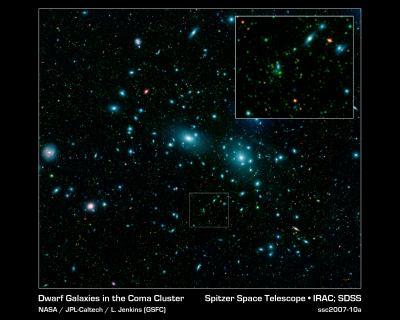The world's largest and most prolific team of planet hunters announced today (Monday, May 28) the discovery of 28 new planets outside our solar system, increasing to 236 the total number of known exoplanets.
Heavens
A newly discovered dwarf galaxy in the Local Group has been found to have formed in a region of space far from our own and is falling into our system for the first time in its history, according to new data obtained at the W. M. Keck Observatory. An international team of astronomers report that the dwarf galaxy, Andromeda XII, marks the best piece of evidence for small galaxies which are just now arriving in our Local Group.
A CME (Coronal Mass Ejection) is a solar body slam to our high-tech civilization. CMEs begin when the sun launches a billion tons of electrically conducting gas (plasma) into space at millions of miles per hour. A CME cloud is laced with magnetic fields, and CMEs directed our way smash into Earth's magnetic field. If the CME magnetic fields have the correct orientation, they dump energy into Earth's magnetic field, causing magnetic storms. These storms can cause widespread blackouts by overloading power line equipment with extra electric current. But wait; there's more.
Using NASA's Far Ultraviolet Spectroscopic Explorer (FUSE) satellite and ground-based telescopes, astronomers have determined, for the first time, the properties of a rare, extremely massive, and young binary star system.
 In just a short amount of time, NASA's Spitzer Space Telescope has bagged more than a thousand previously unknown dwarf galaxies in a giant cluster of galaxies.
In just a short amount of time, NASA's Spitzer Space Telescope has bagged more than a thousand previously unknown dwarf galaxies in a giant cluster of galaxies.
The sharpest image ever taken of the large "grand design" spiral galaxy M81 is being released today at the American Astronomical Society Meeting in Honolulu, Hawaii. A spiral-shaped system of stars, dust, and gas clouds, the galaxy's arms wind all the way down into the nucleus. Click above for full size
Click above for full size
Astronomers have discovered the exact location and makeup of a pair of supermassive black holes at the center of a collision of two galaxies more than 300 million light years away.
Astronomers have used powerful adaptive optics technology at the W. M. Keck Observatory in Hawai‘i to reveal the precise locations and environments of a pair of supermassive black holes at the center of an ongoing collision between two galaxies 300 million light-years away.
The James Clerk Maxwell Telescope (JCMT) on Mauna Kea in Hawaii has a new way to look at the Universe, thanks to two revolutionary instruments called HARP and ACSIS. These instruments operate together, and they recently sliced through the Orion Nebula, recording for the first time the internal movements of its star-forming gases. This movie takes the observer through the data cube and gives a feel of how the gas is moving.
This movie takes the observer through the data cube and gives a feel of how the gas is moving.
Cracks in the icy surface of Saturn's moon Enceladus open and close daily under the pull of Saturn's gravity, according to new calculations by NASA-sponsored researchers.
"Tides generated by Saturn's gravity could control the timing of eruptions from cracks in the southern hemisphere of Enceladus," said Dr. Terry Hurford of NASA's Goddard Space Flight Center, Greenbelt, Md. Hurford is lead author of a paper on this research appearing in Nature May 17.
Two astrophysicists at NASA’s Goddard Space Flight Center in Greenbelt, Md., Nikolai Shaposhnikov and Lev Titarchuk, have successfully tested a new method for determining the masses of black holes.
Astronomers have long suspected the existence of the invisible substance of dark matter as the source of additional gravity that holds together galaxy clusters. Otherwise, astronomers say, the clusters would fly apart if they relied only on the gravity from their visible stars. Although astronomers don't know what dark matter is made of, they hypothesize that it is a type of elementary particle that pervades the Universe.
Travellers have relied on accurate timekeeping for navigation since the development of the marine chronometer in the eighteenth century. Galileo, Europe’s twenty-first century navigation system, also relies on clocks – but they are millions of times more accurate than those earlier timepieces.
"HD 149026b is simply the most exotic, bizarre planet. It’s pretty small, really dense, and now we find that it’s extremely hot."
ESA’s X-ray observatory XMM-Newton has revealed a new class of exploding stars – where the X-ray emission ‘lives fast and dies young’.
The identification of this particular class of explosions gives astronomers a valuable new constraint to help them model and understand stellar explosions. XMM-Newton image of M 31. Credit: ESA
XMM-Newton image of M 31. Credit: ESA